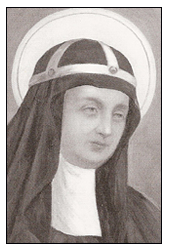 |
 |
| Home | The Saint Bridget Order | Accommodation | Pilgrimages | Prayer's | Services | Events |
|
|
ST. BRIDGET OF SWEDEN
After her children were born, St. Bridget and her husband made a vow of chastity. She had discussions with many learned theologians and was received at the court of King Magnus Eriksson. In 1341, she and her husband made a pilgrimage to Santiago de Compostela. Her husband died in 1344 and thereafter St. Bridget devoted herself entirely to her religion. Her visions became much more frequent. She believed that Christ appeared to her and she wrote down her many revelations. She compiled her revelations into a book, which was later translated into Latin and into verncaular languages. Well known in England by the 15th century, Bridget's devotional writings greatly influenced Margery Kempe’s spirituality. Margery has a vision of the sacrament fluttering in the priest's hands at the moment elevation and hears Christ say to her that "Bridget never saw me in this way" ( Chap. 20, lines 1078-1086). Bridget journeyed to Rome in 1349 and remained there until her death. While living in Rome, she made several pilgrimages, among them one to the Holy Land in 1373. St. Bridget was canonized in October 1391 and her feast day is July 23rd. She is the patron saint of Sweden. She is also known as St. Birgitta, and to the English, as St. Bride. St. Bridget founded an order of nuns, the Bridgittines. Syon Abbey, a Bridgittine house founded by Henry V on the outskirts of London was probably the most distinguished center of female piety in late-medieval England. BRIDGET'S VISION OF THE CRUCIFIXION The Vision Lady Birgitta saw in Jerusalem in the Church of the Holy Sepulchre, in the chapel of Mount Calvary, on the Friday after the octave of the Ascension of the Lord, when, caught up in spirit, she saw the whole passion of the Lord in painstaking detail. Marguerite Tjader Harris and Albert Ryle Kezel, Birgitta of Sweden, Life and Selected Revelations. Paulist Press: Mahwah, NJ., 1990: 188-89. BRIDGET'S VISION OF THE NATIVITY St. Bridgit's writings had a profound and lasting impact on 15th century Renaissance painting in the depiction of the Nativity. She described seeing Mary give birth as if light passed through her body. Joseph has brought Mary a candle since the birth was at night. With the birth, however, the Infant was bathed in a divine light that overwhelmed the material light of the candle. Bridget wrote: “The Mystic of the North”, “ the Spokeswoman of God”: with these and other titles the gigantic figure of Bridget of Sweden imposes herself on our attention as a unique personality, powerful in the vehemence and incisiveness of the message of peace. Belonging to the royal family did not hinder her from climbing the mountain of holiness, evidenced mainly in the “Revelations”, a writing which has made her famous and which, for a correct understanding, must be read and judged in the light of her own life “unceasingly orientated towards God, spent in the study of the Bible, in prayer and meditation, in mysticism and mortification.” A deeply cultured and very practical woman, wife and mother of eight children, humble but bold pilgrim, counsellor to the highest Royalties of the time, she founded the Order which she dedicated to the Most Holy Saviour. We find the Swedish Saint fully involved in events which six centuries later were to engage her spiritual heirs, namely, acting as “a bridge of unity between Rome and the noble Sweden, between the Catholic Church and the Lutheran Churches of Northern Europe”, as Paul VI nicely described it. On the 7th October 1391 the Bull of Canonisation by Boniface IX declared Saint Bridget worthy of veneration in the Universal Church “for the glory of the true Faith … For the solution of the schism in the Church and for the unity of the Faith and of the Church”. She is truly a Saint with European dimensions: since October 1999, together with Blessed Therese of the Cross and Saint Catherine of Siena, she is co-Patron Saint of Europe, a continent with common traditions, faith and history in spite of its various historical vicissitudes. The Swedish Saint has worked hard for the unity of Christians. Her European dimension is recognised by the Catholics and Lutherans alike. |
| Copyright © 2007 Bridgettine Guest House - web design CFWEBDESIGN |
 St. Bridget of Sweden was born in 1303 and died on July 23rd, 1373. Her father, Birger, was the royal prince of Sweden and her mother, Ingeborg, was a very pious woman. She received attentive religious training from a young age and liked to meditate on the Passion of Christ. In 1316, at age thirteen, she was married to Ulf Gudmarsson, who was eighteen. St. Bridget and her husband had eight children, the youngest of whom later became St. Catherine of Sweden.
St. Bridget of Sweden was born in 1303 and died on July 23rd, 1373. Her father, Birger, was the royal prince of Sweden and her mother, Ingeborg, was a very pious woman. She received attentive religious training from a young age and liked to meditate on the Passion of Christ. In 1316, at age thirteen, she was married to Ulf Gudmarsson, who was eighteen. St. Bridget and her husband had eight children, the youngest of whom later became St. Catherine of Sweden.